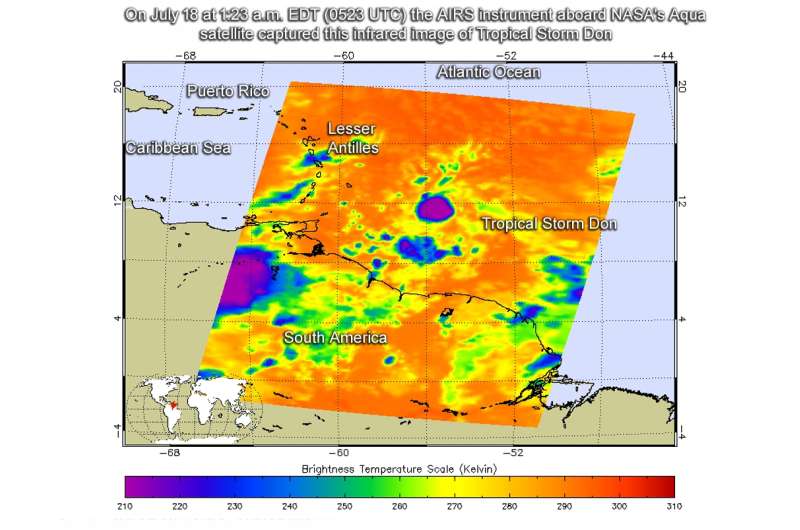NASA looks at compact Tropical Storm Don in infrared light

NASA's Aqua satellite passed over newly formed Tropical Storm Don gathering temperature data from the compact storm's clouds.
At 5 p.m. EDT on July 17 Don formed rapidly from a low pressure area into a tropical storm about 485 miles (780 km) east-southeast of Barbados.
On July 18, a tropical storm warning was in effect for Grenada and St. Vincent and the Grenadines. A tropical storm watch was in effect for Barbados, St. Lucia and Bonaire.
The Atmospheric Infrared Sounder, or AIRS, instrument aboard NASA's Aqua satellite looked at Tropical Storm Don in infrared light. Infrared light provides scientists with temperature data and that's important when trying to understand how strong storms can be. The higher the cloud tops, the colder and the stronger they are. So infrared light as that gathered by the AIRS instrument can identify the strongest storms within a tropical cyclone.
AIRS infrared data gathered on July 18 at 1:23 a.m. EDT (0523 UTC) showed the storm to be compact with a small area of strong thunderstorms around the center. Some cloud top temperatures around the low-level center were as cold as minus 63 degrees Fahrenheit (minus 53 degrees Celsius). The National Hurricane Center noted that there have also been periodic bursts of deep convection very near the center, accompanied by significant clusters of lightning activity, which is indicative of strong updrafts in or near the radius of maximum winds.
By 8 a.m. EDT (1200 UTC) the center of Tropical Storm Don was located near 11.4 degrees north latitude and 57.0 degrees west longitude. That's about 210 miles (335 km) southeast of Barbados. Don was moving toward the west near 18 mph (30 kph). The National Hurricane Center (NHC) expects this general motion to continue with an increase in forward speed through Wednesday evening, July 19. The estimated minimum central pressure is 1,010 millibars.
Maximum sustained winds are near 50 mph (85 kph) with higher gusts. Little change in strength is expected before the system reaches the Windward Islands. Weakening is expected on Wednesday while Don moves across the southeastern Caribbean Sea.
NHC said that on the forecast track, the center of Don will move across the Windward Islands tonight, and then move westward across the southeastern Caribbean Sea on Wednesday.
For updated forecasts, visit: http://www.nhc.noaa.gov
Provided by NASA's Goddard Space Flight Center





















